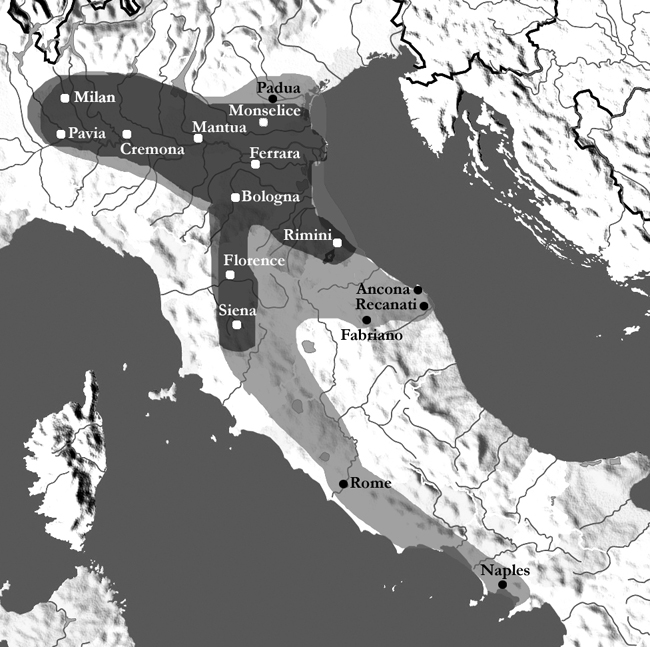1453 AN EARLY ARRIVAL OF TRIUMPHS INTO ROME
by Franco Pratesi, 3.11.2011
 |
Trionfi card developmentclick to enlarge |

|
Many thousands of pages have been written on the origin and first spread of tarot. Instead of summarising the main 'theories', let me start with a rather recent article, which lists the relevant places and dates involved. (1) Two figures of that article are an excellent starting point: one is a map of Italy with regions shadowed in two ways: dark grey, in which trionfo was known before 1452; light grey up to 1475. The second figure is a table in which places and dates, from 1442 to 1482, are put in order - at its bottom we find the year 1442 in correspondence with Ferrara, then on subsequent lines we find Cremona/Milan/Pavia, followed by Florence, Siena, Padua, Bologna, Ancona/Fabriano/Recanati, Mantua, Naples, and Rome. The initial presence in Rome is marked at 1474 and it is this date which is the most interesting here.
It is well known that the best documented initial spread of tarot refers to Ferrara. The documents of the Este court have been preserved and studied for a long time. Recently, card historians could avail themselves of the extraordinary works by Adriano Franceschini (2) and find there further information. A similar work on local documents has been made by Arnold Esch for Rome, with special attention to customs data. He published several articles with new information and discussion, and recently a whole book on the topic.(3) The book includes extended versions of articles already published (in particular increasing the time interval investigated from 20 to 40 years) and the insertion of an unpublished list of items of interest for the fine arts as chapter V: Pittura, scultura, artigianato artistico nei registri doganali di Roma 1445-1485. The various items are listed there in chronological order as one-two lines of text without comments.
As it occurred for Ferrara, these works about Rome have been found to be a useful source by card historians. As far as I know, the first who used them has been Thierry Depaulis, who stressed their relevance to the early history of tarot and made them known to card historians and collectors.(4)
In October 2011, Ross Caldwell found in the publications of Esch further data concerning the import of cards and triumphs into Rome and discussed them with Lothar Teikemeier and other experts in the web(5). The discussion pointed to the fact that the known dates of the first introduction of triumphs in Rome had now to be set about ten years earlier than previously accepted. Moreover, the fact that a trade of dozens of 'common' packs existed at the time was a proof that a standard type of tarot existed earlier than accepted till now. Lothar Teikemeier informed me of this discussion and I was thus induced to check if further information was present in Esch's book. Indeed, I could find two lines in chapter V, on page 270, which correspond to another step backwards in time.
| 1453. Giovanni da Pistoia: "12 immagine di legnio e 8 paia de triunfi da giochare"; dog.: 36 bol. (=10 duc.); reg. 48, fol. 45v, luglio. |
It is impossible to deduce from this information the exact price of the triumph packs imported: 36 bolognini (half a ducat) corresponded to the 5% import tax, but we don't know how the total value of 10 ducats could be distributed between immagine and triunfi; in any case, these triumphs could not be considered as precious items. The fact itself that they were imported as a stock of 8 packs (similar or even identical) is sufficient to indicate a manufacturing and a trade already well established. Moreover, the fact that a tax was paid for them is a proof that these items were addressed to 'common' people and not up to the papal court they got imports without paying any tax.
On the basis of this new data, the map of Italy mentioned above keeps its validity (let me add, for the moment) just because the limit between dark and light grey had been set precisely at the year 1452. The first and direct consequence of the new information is a change in the position of Rome among the earliest documented places in which triumphs were played. The second, less direct, consequence is connected with the seemingly Florentine provenance of these items: they may thus prove that Florence had a major part in the early spread of tarot. I have spent a lot of time researching a rich store of documents here in Florence comparable to those studied for Ferrara and Rome. Hopefully, the names of the Florentine merchants involved in the Roman imports of cards and triumphs will help me to find something useful.
Footnotes:
(1) Ross Caldwell, The Playing-Card, Vol. 36 No. 1 (2007) 51-62.
(2) Adriano Franceschini, Artisti a Ferrara in etÓ umanistica e rinascimentale. Vol. 1. Roma-Ferrara 1993. see Google-Snippet-View
(3) Arnold Esch, Economia, cultura materiale ed arte nella Roma del Rinascimento. Roma 2007 ; see Google-Snippet-View
(4) Thierry Depaulis, The Playing-Card, Vol. 36 No. 3 (2008) 205-211.
(5) Web-Discussion. Ross Caldwell and Lothar Teikemeier cooperated in the collection and presentation of all known Trionfi card notes of the 15th century in the web: see Webpage
Map from Ross Caldwell in 2007 in The Playing Card, vol. 36/1. Table from Ross Caldwell (state 2009). The momentary research (November 2011) has further proceeded.